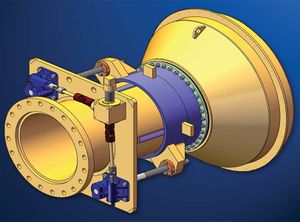Cone Valves
Cone Valve is a divergent valve whose cone-shaped head in a fixed cylinder spreads water around the wide, downstream end of the cone in spillways of dams or hydroelectric facilities. Also known as Howell-Bunger valve.
Cone valves are commonly found as the service Shut-Off Valves in more-expensive water systems and usually found in gas taps . They can be identified by their range of motion only 90° between fully on and fully off. Usually, when the handle is in line with the pipe the valve is on, and when the handle is across the pipe it is closed. A cone valve consists of a shallowly-tapering cone in a tight-fitting socket placed across the flow of the fluid. In UK English this is usually known as a taper-plug cock.
Ball Valves use a spherical ball instead. In either case, a hole through the cone or ball allows the fluid to pass if it is lined up with the openings in the socket through which the fluid enters and leaves; turning the cone using the handle rotates the passage away, presenting the fluid with the unbroken surface of the cone through which it cannot pass. Valves of this type using a cylinder rather than a cone are sometimes encountered, but using a cone allows a tight fit to be made even with moderate manufacturing tolerances. The ball in ball valves rotates within plastic seats.
Components of cone valves
A cone valve is a rugged and highly dependable liquid control valve which can accurately modulate flows under extreme velocity, pressure, and temperature. The cone valve is simple in basic configuration, and made up of three primary components
Actuation Mechanism: Serves the function of lifting and rotating the plug in the body.
Plug: Conically shaped element with a cylindrical bore (full pipe diameter).
Body: Supporting member for the plug. The body enables connection to adjacent piping or equipment, and supports the head which provides a mounting surface for the mechanism.
